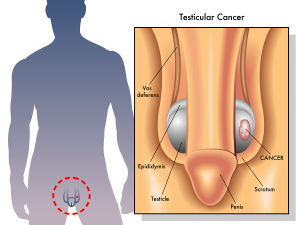Introduction
There has been a quiet revolution between the early 1970’s and the early 1990’s with regard to treatment of testicular cancer. As a result the 5-year cancer survival rates, which were only 10% in the 1970’s, have increased to 90% or more in the 1990’s. Testicular cancer is derived from the germ cell. This is a rapidly dividing cell type, which makes them a good target for both radiotherapy or chemotherapy.
There have been major advances in the treatment with radiotherapy in the 1970’s where it became apparent that much higher survival rates could be achieved when lymph nodes of the paraaortic region were included in the treatment field. Lately cisplatin was introduced as a new chemotherapeutic modality and this was the other link to the success for testicular cancer. As testicular cancer usually occurs only in one testicle, it is often possible to preserve the other testicle by proper shielding from radiotherapy and a washout period following chemotherapy. In this way the patient can still father children after the completed treatment and does not need hormone replacement as the remaining testicle can take over the missing testicle’s hormone function.
We know from prostate cancer research that a lack of testosterone can cause prostate cancer (Ref.8). However, any dysbalance of hormones with aging can make a person more vulnerable to any kind of cancer including testicular cancer (Ref. 7). Testicular tissue has many testosterone receptors and if they are not stimulated by testosterone, and estrogen is relatively too dominant in the aging male (Ref.9), this can cause prostate cancer, testicular cancer and heart attacks.
Summary
The testicular form of germ cell tumors (testicular cancer) has become less of a menace. Early detection and treatment has brought about these good survivals for stage I and II and most men are in this category. Even with germ cell cancers outside the tesicle the survival rates have improved, but the physician must have a high index of suspicion and think of ordering the appropriate CT scan, MRI scan and ultrasound scan coupled with appropriate blood tests. Usually these germ cell tumors are only found in a late stage, but this could improve in future with newer screening tests, which have yet to be developed.
Bio-identical hormone replacement is important for the aging male to prevent prostate cancer, testicular cancer and heart attacks.
Plea for testicle self examination : Let me leave you with one thought and plea: Examine your testicles once per month consciously or ask your sex partner to examine them once per month for you. If there is any change or a new hard area, see your physician right away. It may not be cancerous, but have it checked out, just in case!
References:
1. Cancer: Principles &Practice of Oncology.4th edition. Edited by Vincent T. DeVita, Jr. et al. Lippincott, Philadelphia,PA, 1993. Chapter on Cancer of the Testis.
2. Cancer: Principles&Practice of Oncology. 5th edition, volume 1. Edited by Vincent T. DeVita, Jr. et al. Lippincott-Raven Publ., Philadelphia,PA, 1997. Chapter on Cancer of the Testis.
3. Votrin II et al. Drugs Exp Clin Res 2000;26(5-6):267-273.
4. B Aschhoff Drugs Exp Clin Res 2000;26(5-6):249-252.
5. Conn’s Current Therapy 2004, 56th ed., Copyright © 2004 Elsevier
6. Ferri: Ferri’s Clinical Advisor: Instant Diagnosis and Treatment, 2004 ed., Copyright © 2004 Mosby, Inc
7. John R. Lee: “Hormone Balance for Men – What your Doctor May Not Tell You About Prostate Health and Natural Hormone Supplementation”, © 2003 by Hormones Etc.
8. Abraham Morgentaler, MD “Testosterone for Life – Recharge your vitality, sex drive, muscle mass and overall health”, McGraw-Hill, 2008
9. http://www.dcnutrition.com/miscellaneous/detail.cfm?RecordNumber=475 (Winston W. Greene, B.A.,B.S., D.C.: “MALE HORMONES – General Discussion”)







